In a high growth environment, companies tend to lose focus of customer onboarding and training in the whirlwind. Customers need to learn and adopt the product and begin to realize value as soon as possible. But with limited resources and a rapidly expanding customer base, organizations cannot afford to stick to old-school onboarding methods - especially with customer education and training.
{{demo}}
Why is customer education and training important?
Customer education and training are vital for effective customer onboarding. They help unlock the full potential of any product or software and prevent churn.
Exemplary companies like HubSpot and Cloudera prioritize customer education to drive loyalty and adoption.
At the core of effective customer education and training is the recognition that different customers have varying levels of familiarity and proficiency with your product. By assessing customers' maturity levels, you can tailor their training approaches to meet specific needs and deliver targeted support.
Early-stage customers often require reactive training, where requests for assistance can be addressed on an ad-hoc basis. While this approach can suffice initially, it lacks scalability and repeatability, posing challenges for both customers and your organization.
Moving beyond reactive training, organizations can transition to a performing stage, where they develop structured training modules based on common customer needs. This enables them to provide more consistent and repeatable training experiences, albeit still tailored to individual requirements.
Ultimately, the goal is to establish customer education as a strategic function within the organization. This involves implementing tools, expanding training offerings, and integrating with other business functions to create a comprehensive training ecosystem.
In a recent Preflight conversation about customer onboarding and training during high growth, we were able to uncover profound insights and innovative solutions to improve user engagement and completion rates.
Here’s what Preflighters had to say on the topic:
Shawn Riedel, Executive Leader at Fractional Customer Success
- Shorter, more frequent sessions: Recognize the limited attention spans of users and offer training in smaller, more manageable chunks. Aim for just-in-time learning to enhance retention and application of skills.
- Effective gamification: Utilize gamification strategies to engage users without sacrificing the actual impact of the exercise. Incorporate elements that show progress over time and elevate the perception of the training process.
- Integration with day-to-day activities: Reinforce training content by integrating it with users' daily activities within the application. Provide just-in-time prompts and support to encourage immediate application of newly learned skills.
- Change management: Implement a comprehensive change management plan endorsed by executive sponsors. Clearly communicate the reasons behind the change, expected benefits, and timeline for adoption. Ensure executive buy-in and active support throughout the process.
- Assessment and adaptation: Conduct an ‘Onboarding Readiness Assessment’ to understand user expectations and cultural dynamics. This also helps set expectations with customers. Tailor training approaches based on client characteristics and preferences. Continuously evaluate and refine the onboarding experience to address any shortcomings and improve customer retention.
- Incentivize completion: Consider gating certain features until users complete required training modules. Align milestones and incentives with executive-approved objectives to prioritize training completion and drive adoption. Also, time-to-value is not an effective metric to measure the success of your training because the time-to-value for each customer is different and should be more customer-centric.
- Reevaluate your customer onboarding experience: Challenge existing onboarding processes and be willing to overhaul them if necessary. Prioritize user experience and effectiveness over adherence to tradition. Invest in revamping the customer onboarding experience to prevent churn and maintain brand reputation.
Srikrishnan Ganesan, CEO & Co-founder at Rocketlane
Try embracing new content formats and delivery methods to enhance user engagement and consumption. Short-form videos sent over platforms like Slack may be more appealing and accessible to users, facilitating easier consumption of training material.
Additionally, the necessity for extensive training, especially for leadership, should be reconsidered in light of busy schedules. Instead of lengthy training sessions, prioritizing key content and scheduling shorter, more focused sessions could be more effective. Implement calendar discipline by blocking out dedicated time for training sessions to ensure executive sponsors or stakeholders on the customers’ side participate and prioritize essential content within the training curriculum.
Andres, Partner, Principal Consultant Partner, Principal Consultant at AYP Consulting LLC
For effective training in a seemingly mundane field like payroll, a systematic approach helped significantly improve user engagement and completion rates. Here’s what we did:
- Content segmentation: Initially, we developed approximately 5 hours of content but recognized the need to streamline it for better usability. We then categorized content into critical information and material for power users.
- Structured pathways: We created a basic path consisting of essential information, totaling to 1.5 hours approximately. This path was divided into two 45-minute courses, with interactive elements such as quizzes strategically placed throughout to maintain engagement.
- Visual progress tracking: We employed a progress bar similar to a Domino's pizza oven, and users could track their advancement through the courses, enhancing motivation and providing a sense of accomplishment.
- Optional pathways and advanced courses: To cater to diverse user needs, we included optional pathways for further exploration. Advanced courses covering optional topics were provided at the end of the training curriculum and users could always access them based on their interest.
- LinkedIn certification badges: Implementing LinkedIn certification badges added a layer of recognition and validation for users upon completion of training, further incentivizing participation.
- Exclusive user community: We established an exclusive user community, accessible only to individuals who completed the training. This created a sense of exclusivity and belonging, motivating users to engage with the training materials.
Later, we realized that implementing these strategies improved completion rates from around 25 percent to approximately 80 percent, demonstrating the effectiveness of a well-structured and engaging training program.
How does customer training and education work at your organization? Who owns this part of the customer onboarding process and how do you evaluate the effectiveness of the process? Join the discussion on the Preflight Community!



.avif)















